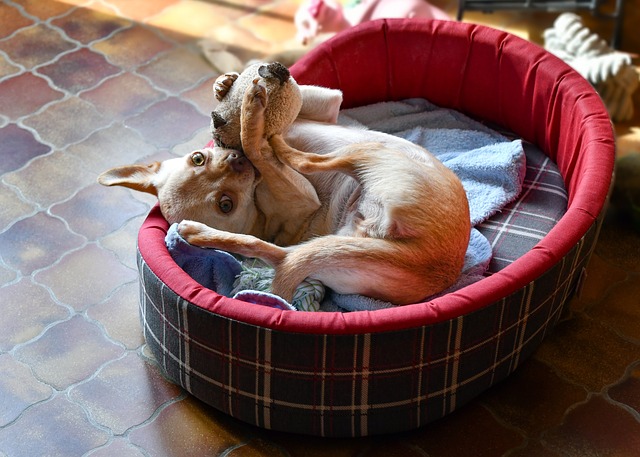When it comes to your furry best friend, their safety is always a top priority. This includes not only their diet and exercise routine but also the toys they play with. It’s important to evaluate each toy thoroughly to ensure it’s safe for your dog to play with.
In this article, we’ll guide you through the process of evaluating toys for your dog’s safety.
First and foremost, you need to understand your dog’s needs. Different breeds and sizes have different play styles and preferences. Some dogs may be aggressive chewers, while others may prefer soft and cuddly toys. By understanding your dog’s needs, you can choose toys that will keep them entertained and safe.
Additionally, evaluating the durability, size, and material of the toy, reading product reviews, monitoring your dog’s playtime, and disposing of toys safely are all important steps to take when choosing the right toys for your furry friend.
By following these guidelines, you can ensure that your dog’s playtime is not only fun but also safe.
Understand Your Dog’s Needs
Get to know what your furry friend needs to have a great playtime experience. Understanding your dog’s behavior is key to selecting the right toy for them.
Some dogs enjoy playing fetch, while others prefer to chew on toys. Observe your dog’s behavior and see what they like. If they like to chew, then invest in durable toys that can withstand their chewing. If they enjoy playing with you, get a toy that you can throw and play fetch together.
It’s important to meet your dog’s physical needs too. For example, if your dog is a large breed, they will need a bigger toy that can handle their strength and size. Meeting your dog’s physical needs also means taking into consideration their age and activity level.
Younger dogs will require more playtime and stimulation than older dogs. If your dog is highly active, then consider getting toys that can keep up with their energy level. On the other hand, if your dog is more laid back, then a simple stuffed toy might be just what they need.
Remember, toys are not just for fun but also for your dog’s well-being. By understanding their behavior and physical needs, you can select the right toy that will keep them happy and healthy.
Check for Toy Durability
Make sure you’re getting the most bang for your buck by choosing toys that can handle your pup’s rough play. When evaluating toys for your dog’s safety, durability is a crucial factor to consider. You want to choose toys that can withstand your dog’s strong jaws and rough playstyle without falling apart or posing a choking hazard.
To ensure the durability of a toy, look for those that meet toy safety standards and have undergone testing methods. These standards and tests ensure that the toys are made of high-quality materials and are safe for your dog to play with.
However, even with durable toys, there are still common toy hazards that you should watch out for, such as small or detachable parts that your dog can swallow or choke on. To prevent these hazards, regularly inspect your dog’s toys for any signs of wear and tear, and always supervise your dog during playtime to prevent any accidents.
Evaluate Toy Size
Don’t risk your furry friend’s health by overlooking the importance of toy size – make sure you choose toys that are appropriate for their size and playstyle. Toy size evaluation is crucial to ensure your dog’s safety while playing.

Small toys can be a choking hazard for larger dogs, while bigger toys can be too heavy for smaller dogs to carry around or play with comfortably. When selecting toys, consider your dog’s size and breed. Smaller dogs may need smaller toys, while larger breeds may require more robust toys to withstand their playstyle. Always check the manufacturer’s recommended size and weight limits to ensure that the toy is suitable for your dog.
Additionally, observe your dog’s playstyle to determine the type of toy they prefer. A dog that likes to chew may need a durable chew toy, while a dog that loves to play fetch will enjoy a ball or frisbee. By evaluating toy size, you can ensure that your dog has a safe and enjoyable playtime.
Consider Toy Material
Now that we’ve covered the basics of toy size, let’s dive into the fun stuff – what type of materials will provide your furry friend with maximum enjoyment without sacrificing style?
When evaluating toy materials, it’s important to consider non-toxic options to ensure your dog’s safety. Look for toys that are labelled as BPA-free, phthalate-free, and made with food-grade materials. This will ensure that your pup won’t ingest harmful chemicals or toxins while playing with their favourite toy.
In addition to non-toxic options, also consider eco-friendly alternatives. Many dog toys are made with sustainable materials such as recycled plastic, organic cotton, and natural rubber. These materials not only benefit the environment, but they also provide your dog with a safer and healthier toy option.
When shopping for toys, consider the impact on the planet and choose toys that are both safe and environmentally responsible.
Read Product Reviews
You’ll want to check out product reviews to get the inside scoop on the best toys for your furry friend. Reading reviews can help you identify reliable sources for purchasing safe and long-lasting toys.
It’s important to compare reviews from different sources to get a comprehensive understanding of the product’s quality and durability. When reading reviews, pay attention to any common complaints or issues that other pet owners have experienced. This can help you determine whether the toy is suitable for your dog’s needs and play style.
Additionally, look for reviews from pet owners with similar dogs to yours, as they may have more relevant insights. By taking the time to read product reviews, you can make an informed decision and ensure that your dog’s toys are safe and enjoyable for them.
Monitor Your Dog’s Playtime
When it comes to playing time with your furry friend, it’s important to remember to always supervise them. This means keeping a watchful eye on their behavior and ensuring they’re safe at all times.
Additionally, if you notice any broken or damaged toys, be sure to take them away to prevent any potential harm.
Finally, rotating your dog’s toys can help keep them interested and engaged in playtime, preventing boredom and potentially destructive behaviour.
Supervise Your Dog During Playtime
Make sure to always keep an eye on your furry friend while they’re playing to ensure their playtime is enjoyable and safe. Supervising your dog during playtime is crucial in preventing any accidents or injuries that may occur. This is especially important when introducing new toys or playmates to your pup’s routine.
As mentioned in the previous subtopic, the importance of interaction and balancing playtime can’t be overstated. By supervising your dog during playtime, you can ensure that they’re playing safely and not getting too carried away. You can also intervene if you notice any aggressive behaviour or if your dog is getting tired and needs a break.
Remember, your dog’s safety is always your top priority, and by supervising their playtime, you can make sure that they’re having fun while staying safe.
Take Away Broken or Damaged Toys
It’s important to toss any damaged toys your pup may have to prevent any potential harm or discomfort during playtime. Inspect regularly to ensure there are no cracks, missing parts, or sharp edges that could pose a threat to your dog’s safety. Replace when necessary to avoid hazards that could lead to choking, cuts, or other injuries.
Supervise playtime with your dog to ensure they’re using the toys appropriately and not chewing off small parts that could be swallowed. If you notice any signs of discomfort or injury, seek veterinary attention immediately.
Provide appropriate toys that are suitable for your dog’s age and breed, and avoid toxic materials that could be harmful if ingested. Consider your dog’s chewing habits and avoid toys that are easily destroyed or could break into small pieces.
By taking these precautions, you can ensure that your dog’s playtime is both enjoyable and safe.
Rotate Toys to Keep Your Dog Interested
Switching up your pup’s playthings regularly can keep their interest piqued and prevent boredom during their playtime. It not only makes playtime more enjoyable for your furry friend but also provides the benefits of variety and helps prevent destructive chewing behaviour.
Introducing new toys gradually can also help your dog adjust to new textures and smells, preventing any potential allergies or negative reactions. Rotating toys can also help you identify any potential safety hazards or damage to toys.
Regularly inspecting your dog’s toys can prevent accidents like choking or ingestion of small parts. If you notice any signs of wear and tear, immediately take the damaged toy away from your dog. Remember, the safety of your dog should always come first, so regularly rotating and inspecting their toys is a crucial part of keeping them safe and happy.
Dispose of Toys Safely
When it comes to the safety of your furry friend, it’s important to not overlook the proper disposal of their toys.
You should always try to recycle toys that are no longer usable, instead of just throwing them away.
If a toy is beyond repair, it should be thrown away immediately to prevent your dog from accidentally ingesting any harmful material.
Lastly, avoid leaving toys lying around the house, as this can lead to tripping hazards and potential accidents for both you and your pup.
Recycle Toys if Possible
If you’re looking for a way to reduce waste and give your furry friend a new toy, consider recycling old toys they no longer play with. Creative recycling is a great eco-friendly alternative to throwing away toys that are still in good condition. Not only does it benefit the environment, but it also saves you money in the long run.
One way to recycle old toys is to donate them to a local animal shelter or rescue organization. Many shelters are always in need of toys for their animals, and your old toys could be just what they need to keep their furry residents happy and entertained.
Another option is to repurpose old toys into new ones. For example, you can take an old stuffed animal and remove the stuffing to create a tug toy. The possibilities are endless, and your dog will love the new toy just as much as they did the old one.
So, instead of throwing away old toys, get creative and give them a new life.
Throw Away Toys That Cannot Be Repaired
Before tossing out old toys, make sure they’re as broken as a cracked mirror and cannot be repaired. Repairing your dog’s toys is an excellent way to save money and reduce waste. However, there are times when a toy is beyond repair, and you’ll have to get rid of it.
In such cases, it’s important to consider the options available. Repair vs replace: weighing options will help you make an informed decision. If the toy can be repaired, it’s best to do so. But if it’s beyond repair, then it’s time to throw it away.
When throwing away toys that cannot be repaired, it’s important to be aware of toy recycling: benefits and process. Recycling toys is a great way to reduce waste and help the environment. It’s an eco-friendly solution that involves converting old toys into new products.
You can either donate the toys to a local charity or recycle them through a toy recycling program. By doing so, you’ll not only help the planet but also give back to the community. It’s a win-win situation, and your dog will thank you for it.
Avoid Leaving Toys Lying Around the House
Make sure you’re not tripping over toys or having them clutter up your living space by avoiding leaving them lying around the house. Not only can they be a nuisance, but they can also be a safety hazard for both you and your dog.
To avoid this, invest in toy storage solutions that’ll keep your dog’s toys organized and out of the way. You can find various options, such as toy chests or baskets, that’ll blend in with your home decor and keep your space tidy.
Another way to prevent toys from being scattered around your house is to train your dog to pick up their toys. Teaching them to put their toys back in the designated storage area will not only help with the clutter but will also provide mental stimulation for your furry friend.
Positive reinforcement techniques can be used to encourage your dog to pick up their toys and put them away. This’ll not only make your life easier but will also provide a fun and interactive activity for your dog to participate in.
Frequently Asked Questions
How do I know if my dog is playing with a toy safely?
When it comes to determining whether your dog is playing with a toy safely, there are a few supervision tips to keep in mind.
First, make sure that you’re always present while your dog is playing with any toy. This’ll allow you to intervene if your dog begins to chew or ingest any part of the toy.
Additionally, be aware of common hazards such as small parts that can be easily swallowed or sharp edges that could cause injury.
By keeping a watchful eye and taking necessary precautions, you can ensure that your dog is playing with their toys in a safe and enjoyable manner.
Can I give my dog a toy that has small parts or pieces?
Before giving your dog a toy with small parts or pieces, it’s important to consider toy safety standards and potential choking hazards. Small parts can easily break off and become lodged in your dog’s throat, causing serious harm or even death.
Toy safety standards vary by country, but in general, toys should be labeled with age recommendations, be free from harmful chemicals, and not have small parts or pieces that can easily detach. When choosing a toy for your dog, be sure to read the label and inspect the toy for any signs of wear or damage.
If a toy appears to be falling apart or has small parts that could break off, it’s best to avoid giving it to your dog altogether. Safety should always be the top priority when it comes to your furry friend’s toys.
What types of toys are best for dogs with aggressive chewing habits?
If your dog is an aggressive chewer, you’ll want to look for durable options when it comes to toys. Toys made from materials like rubber or nylon tend to hold up better against tough chewing habits.
Additionally, training techniques can be helpful in redirecting your dog’s chewing behavior. Teaching your dog ‘leave it’ or ‘drop it’ commands can help prevent them from destroying their toys and potentially ingesting harmful pieces.
It’s also important to supervise your dog during playtime to ensure their safety and prevent any accidents. By providing your aggressive chewer with durable toys and using proper training techniques, you can keep them entertained and safe.
Are there any specific materials I should avoid when choosing toys for my dog?
When choosing toys for your dog, it’s important to be mindful of potential chemical hazards that may be present in certain materials. Toxic dyes, in particular, can be harmful to your pet’s health.
To avoid these risks, look for eco-friendly options that are free from harmful chemicals and toxins. Natural alternatives, such as toys made from organic cotton or hemp, are a great choice for pet owners who want to ensure their dog’s safety.
By selecting toys made from safe, non-toxic materials, you can provide your furry friend with entertainment and enrichment without putting their health at risk.
How often should I replace my dog’s toys?
Dog toys can be expensive, so it’s understandable to want to make them last as long as possible. However, toy durability is not infinite, and signs of wear and tear can indicate that it’s time to replace a toy.
Although it may be tempting to hold onto a favourite toy, it’s important to regularly inspect it for damage, such as tears, holes, or loose pieces. If you notice any of these signs, it’s time to replace the toy.
Not only can damaged toys be a choking hazard, but they can also pose a risk of ingestion or injury. So, while you may be hesitant to part with your furry friend’s beloved toy, remember that safety should always come first.
Conclusion
Congratulations on reading this article about evaluating toys for your furry friend’s safety! You’re already one step ahead of those clueless dog owners who just throw any old toy at their pups and hope for the best.
But let’s not get too ahead of ourselves, shall we? After all, we know you’re still wondering if you’re doing everything right.
Well, fear not, fellow dog parent. By following the steps outlined in this article, you’ll be able to keep your canine companion safe and entertained for hours on end. And who knows, you might even impress your friends with your newfound knowledge and expertise on dog toys.
Just don’t let it go to your head, or your dog might start to think they’re not the smartest one in the room anymore.




